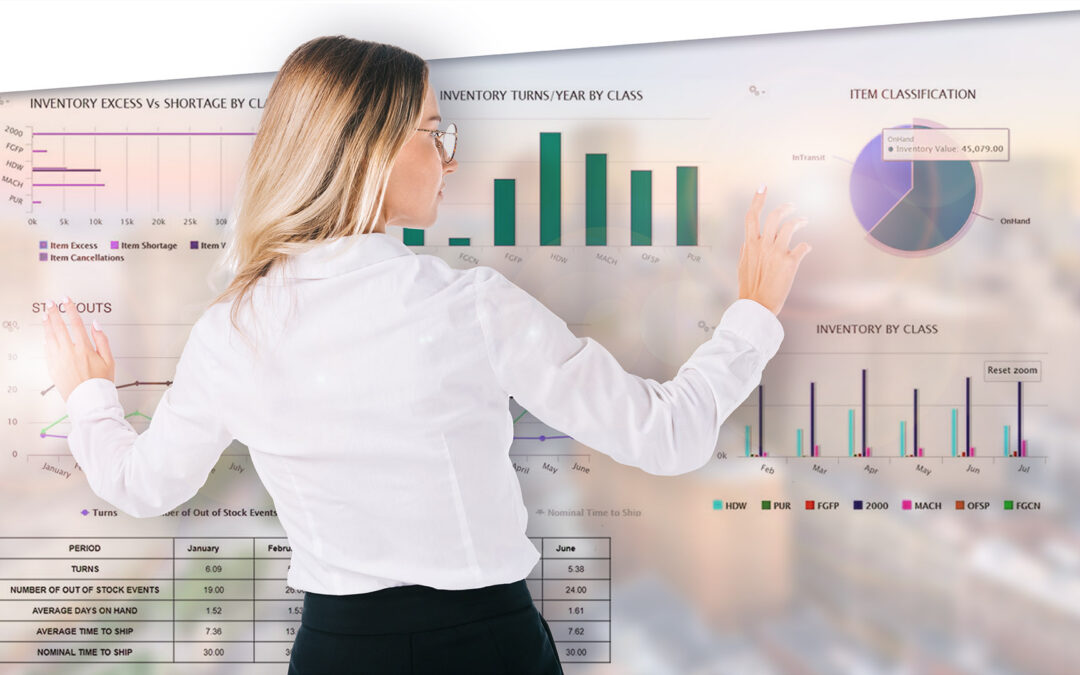
Confused about AI and Machine Learning?
Are you confused about what is AI and what is machine learning? Are you unsure why knowing more will help you with your job in inventory planning? Don’t despair. You’ll be ok, and we’ll show you how some of whatever-it-is can be useful.

Centering Act: Spare Parts Timing, Pricing, and Reliability
In this article, we’ll walk you through the process of crafting a spare parts inventory plan that prioritizes availability metrics such as service levels and fill rates while ensuring cost efficiency. We’ll focus on an approach to inventory planning called Service Level-Driven Inventory Optimization. Next, we’ll discuss how to determine what parts you should include in your inventory and those that might not be necessary. Lastly, we’ll explore ways to enhance your service-level-driven inventory plan consistently.

How to Forecast Inventory Requirements
Forecasting inventory requirements is a specialized variant of forecasting that focuses on the high end of the range of possible future demand. Traditional methods often rely on bell-shaped demand curves, but this isn’t always accurate. In this article, we delve into the complexities of this practice, especially when dealing with intermittent demand.

Six Demand Planning Best Practices You Should Think Twice About
Every field, including forecasting, accumulates folk wisdom that eventually starts masquerading as “best practices.” These best practices are often wise, at least in part, but they often lack context and may not be appropriate for certain customers, industries, or business situations. There is often a catch, a “Yes, but”. This note is about six usually true forecasting precepts that nevertheless do have their caveats.

Explaining What “Service Level” Means in Your Inventory Optimization Software
Navigating the intricacies of stocking recommendations can often lead to questions about their accuracy and significance. A recent inquiry from one of our customers prompted an insightful discussion on the nuances of service levels and reorder points. During a team meeting, we identified unusual gaps between our Smart-suggested reorder points (ROP) at a 99% service level and the customer’s current ROP. In this post, we unravel the concept of a “99% service level” and its implications for inventory optimization, shedding light on how timing and immediate stock availability play pivotal roles in meeting customer expectations and remaining competitive in diverse industries.

The Automatic Forecasting Feature
Automatic forecasting is the most popular and most used feature of SmartForecasts and Smart Demand Planner. Creating Automatic forecasts is easy. But, the simplicity of Automatic Forecasting masks a powerful interaction of a number of highly effective methods of forecasting. In this blog, we discuss some of the theory behind this core feature. We focus on Automatic forecasting, in part because of its popularity and in part because many other forecasting methods produce similar outputs. Knowledge of Automatic forecasting immediately carries over to Simple Moving Average, Linear Moving Average, Single Exponential Smoothing, Double Exponential Smoothing, Winters’ Exponential Smoothing, and Promo forecasting.

5 Steps to Improve the Financial Impact of Spare Parts Planning
In today’s competitive business landscape, companies are constantly seeking ways to improve their operational efficiency and drive increased revenue. Optimizing service parts management is an often-overlooked aspect that can have a significant financial impact. Companies can improve overall efficiency and generate significant financial returns by effectively managing spare parts inventory. This article will explore the economic implications of optimized service parts management and how investing in Inventory Optimization and Demand Planning Software can provide a competitive advantage.

Don’t blame shortages on problematic lead times.
Lead time delays and supply variability are supply chain facts of life, yet inventory-carrying organizations are often caught by surprise when a supplier is late. An effective inventory planning process embraces this fact of life and develops policies that effectively account for this uncertainty. Sure, there will be times when lead time delays come out of nowhere and cause a shortage. But most often, the shortages result from:

A Gentle Introduction to Two Advanced Techniques: Statistical Bootstrapping and Monte Carlo Simulation
Smart Software’s advanced supply chain analytics exploits multiple advanced methods. Two of the most important are “statistical bootstrapping” and “Monte Carlo simulation”. Since both involve lots of random numbers flying around, folks sometimes get confused about which is which and what they are good for. Hence, this note. Bottom line up front: Statistical bootstrapping generates demand scenarios for forecasting. Monte Carlo simulation uses the scenarios for inventory optimization.

How does your ERP system treat safety stock?
Is safety stock regarded as emergency spares or as a day-to-day buffer against spikes in demand? Knowing the difference and configuring your ERP properly will greatly benefit your bottom line. It is critical to understand how your ERP configurations will impact treatment of safety stock and replenishment orders/production job suggestions. Doing so ensures that unintended mistakes that cause inventory bloat and shortages can be avoided.

Bottom Line Strategies for Spare Parts Planning
Managing spare parts presents numerous challenges, such as unexpected breakdowns, changing schedules, and inconsistent demand patterns. Traditional forecasting methods and manual approaches are ineffective in dealing with these complexities. To overcome these challenges, this blog outlines key strategies that prioritize service levels, utilize probabilistic methods to calculate reorder points, regularly adjust stocking policies, and implement a dedicated planning process to avoid excessive inventory. Explore these strategies to optimize spare parts inventory and improve operational efficiency.

Top 4 Moves When You Suspect Software is Inflating Inventory
Discover the key strategies to tackle inventory inflation caused by software in your supply chain. We often are asked, “Why is the software driving up the inventory?” The answer is that Software isn’t driving it in either direction – the inputs are driving it, and those inputs are controlled by the users (or admins). Here are four things you can do to get results you expect.

6 Observations About Successful Demand Forecasting Processes
Forecasting is both an art and a science, requiring a balance between professional judgment and objective statistical analysis. In this blog, we will explore how to generate accurate predictions by leveraging statistical methods, incorporating business knowledge, and enhancing credibility through refinement and graphical representation. Learn about aligning techniques with data nature and integrating them with other business processes, creating a comprehensive planning approach that acknowledges margin of error and forecast bias. Gain the principles and techniques for successful demand forecasting, empowering informed decision-making and optimized planning.

Don’t Blame Excess Stock on “Bad” Sales / Customer Forecasts
Sales forecasts are often inaccurate simply because the sales team is forced to give a number even though they don’t really know what their customer demand is going to be. Let the sales teams sell. Don’t bother playing the game of feigning acceptance of these forecasts when both sides (sales and supply chain) know it is often nothing more than a WAG.

What makes a probabilistic forecast?
What’s all the hoopla around the term “probabilistic forecasting?” Is it just a more recent marketing term some software vendors and consultants have coined to feign innovation? Is there any real tangible difference compared to predecessor “best fit” techniques? Aren’t all forecasts probabilistic anyway?










